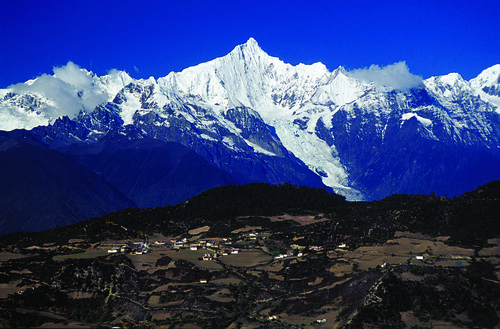Posted:
12/12/2012 |
 Print Friendly Version
Print Friendly Version

NEW BOOK DETAILS THE EXCEPTIONAL BIOLOGICAL AND CULTURAL DIVERSITY OF KHAWA KARPO, SACRED MOUNTAIN OF TIBET
“Khawa Karpo: Tibetan Traditional Knowledge and Biodiversity Conservation”
Now Available from Missouri Botanical Garden Press
(ST. LOUIS): The Tibetan sacred mountain Khawa Karpo, a verdant, snow-capped high peak of the eastern Himalayas, supports one of the world’s most exceptional areas of plant and animal diversity and endemism, from the sacred snow lotus to the endangered snow leopard. Monsoon rains, precipitous topography dissected by rivers and the interaction of tropical and temperate floras have influenced this region, valued not only for its global ecological significance but also by Tibetan Buddhists for its tremendous religious significance. Now, this critical biodiversity hotspot is threatened with destruction from climate change, the stripping of resources and rapid development. Dr. Jan Salick, ethnobotanist and climate change scientist at the Missouri Botanical Garden in St. Louis, and Robert Moseley, director of conservation for The Nature Conservancy in Illinois, are leaders of conservation programs attempting to weave together goals of both biodiversity and cultural conservation in this region. In their new book, “Khawa Karpo: Tibetan Traditional Knowledge and Biodiversity Conservation,” Salick and Moseley detail their vital conservation programs focused on Tibetan traditional knowledge of ethnobotany, ecology and natural resource management.
“Conservation is often done by scientists as a top-down activity, but this book illustrates our efforts to do conservation from the bottom-up,” said Salick. “Our research is focused on traditional Tibetan knowledge, based on Tibetan sacred sites, Tibetan medicines and doctors’ knowledge of them, the Tibetan people’s traditional uses of their Himalayan landscape and their adaptations to and mitigations of climate change. It is a particularly challenging way to work, but ethnobotanists must incorporate traditional ecological knowledge with scientific methods to develop conservation recommendations and procedures that can successfully protect places like Khawa Karpo and its incredible diversity.”

Mount Khawa Karpo lies within the Menri mountain range that straddles the border of Tibet and Yunnan in southwest China, where alpine and temperate systems of the Tibetan Plateau meet the subtropical and tropical systems of Southeast Asia. A unique combination of factors including rainfall patterns and physical relief contribute to its being the most biologically-diverse temperate ecosystem on Earth. The area (known as “Medicine Mountains” by Tibetans) is celebrated both for its sacred geography and its abundance of plants used in traditional Tibetan medicine. It is recognized as a UNESCO (United Nations Educational, Scientific and Cultural Organization) World Heritage site.
The golden monkey, giant panda, red panda, blue sheep and many pheasants are among the animal species endemic to this region. Plants are an integral part of Tibetan life and culture. Snow lotus, blue poppies and corydalis are among the genera of plants found in these mountains, as are wild relatives of common garden plants like peonies, hydrangeas, rhododendrons and lilacs.
Recent regional, national and international policies and economic developments are bringing rapid change to the region. Economic development is capitalizing on the natural and cultural resources of the Khawa Karpo area. The development of mining, non-timber products and agricultural products is increasing, as is tourism. These threats to biodiversity are now evident. Large cats (including the snow leopard) and ungulates are endangered; many rare and endemic plants are threatened. Populations of plants harvested for medicine and horticulture are declining.
The influx of Chinese and Western culture is also influencing traditional Tibetan culture. As religion, culture and language evolve and transform, traditions deteriorate, and with them the traditional ecological knowledge on which the area’s biodiversity depend—thus threatening biodiversity.

“The rich biodiversity under threat drew The Nature Conservancy to Khawa Karpo in 2000 to work with the local government on a conservation and development plan,” said Moseley. “We arrived with a standard conservation planning toolset, but quickly realized Tibetan society has much to teach us about sustainable use of the area’s natural resources. The ethnobotanical approach of Missouri Botanical Garden scientists provided that bridge between Western science and traditional knowledge in designing effective conservation programs.”
“We believe nature conservation can learn from and reinforce indigenous Tibetan practices at all scales,” added Salick.
“Khawa Karpo: Tibetan Traditional Knowledge and Biodiversity Conservation” (ISBN 978-1-935641-06-3) details the employ of ethnobotany—the study of plants, people and their environments—to document the biocultural diversity of Khawa Karpo, traditional Tibetan ecological knowledge and indigenous methods of conservation and natural resource management. The monograph also includes an inside look at Tibetans’ views on their changing landscape, full-color photographs and the first comprehensive checklist of plants and animals of the area. The book is available for $55 from MBG Press by emailing orders@mbgpress.org or calling (877) 271-1930. It is also available on Amazon.com.
Today, 153 years after opening, the Missouri Botanical Garden is a National Historic Landmark and a center for science, conservation, education and horticultural display. With scientists working in 35 countries on six continents around the globe, the Missouri Botanical Garden has one of the three largest plant science programs in the world and a mission “to discover and share knowledge about plants and their environment in order to preserve and enrich life.” Learn more at www.mobot.org.
The Missouri Botanical Garden focuses its work on areas that are rich in biodiversity yet threatened by habitat destruction, and operates the world’s most active research and training programs in tropical botany. Garden scientists collaborate with local institutions, schools and indigenous peoples to understand plants, create awareness, offer alternatives and craft conservation strategies. The Missouri Botanical Garden is striving for a world that can sustain us without sacrificing prosperity for future generations, a world where people share a commitment to managing biological diversity for the common benefit.
# # #
NOTE: Digital images available by request or via Flickr. Download media materials at www.mobot.org/media.
The Missouri Botanical Garden’s mission is “to discover and share knowledge about plants and their environment in order to preserve and enrich life.” Today, 153 years after opening, the Missouri Botanical Garden is a National Historic Landmark and a center for science, conservation, education and horticultural display.